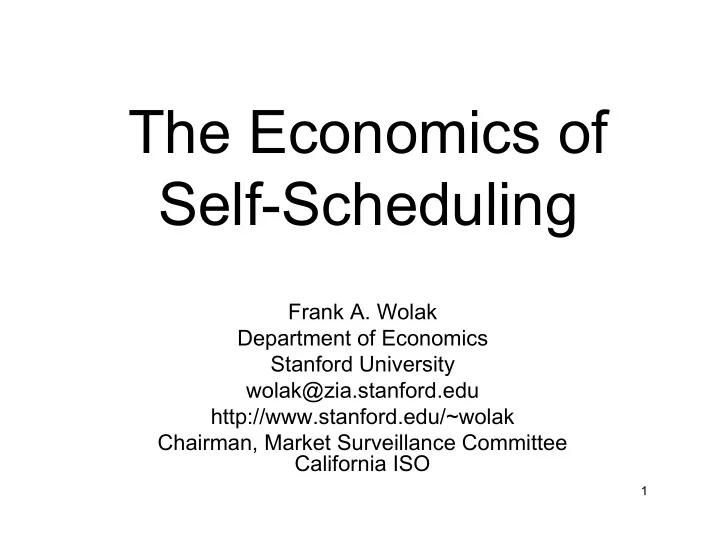

The Economics of Self-Scheduling Frank A. Wolak Department of Economics Stanford University wolak@zia.stanford.edu http://www.stanford.edu/~wolak Chairman, Market Surveillance Committee California ISO 1
The Economics of Self-Scheduling • Why does self-scheduling occur? • Should self-scheduling occur in a competitive market? • What are the costs and benefits • What are the costs and benefits of self-scheduling? • What can be done to limit the amount of self-scheduling? 2
Why Does Self-Scheduling Occur? • Two possible answers – Suppliers are not expected profit-maximizers • May value both higher expected profits and a lower variance in profits – Offer cap and offer floor are too low for suppliers to find it expected profit-maximizing to submit offer curves • Hourly payoff of supplier in multi-settlement market – Π (p DA ,p RT ) = P F Q F + (Q DA – Q F )P DA + (Q RT – Q DA )P RT – C(Q RT ) – Π (p DA ,p RT ) = P F Q F + (Q DA – Q F )P DA + (Q RT – Q DA )P RT – C(Q RT ) – P F = long-term contract price, Q F = long-term contract quantity – P DA = day-ahead price, Q F = day-ahead quantity – P RT = real-time price, Q F = real-time quantity – C(Q RT ) = total cost of producing Q RT • Conclusion—Supplier has potential to increase expected profits by submitting a price responsive offer curve that shifts output sold across markets as a function of the market price if offer cap is high enough and offer floor is low enough 3
Should Self-Scheduling Occur? • Self-scheduling clearly reduces cost of market participation to generation unit owner – Supplier just submits generation schedule to market operator – This is unlikely to maximize expected profits for above reasons • Self-scheduling unlikely to enhance market efficiency or system reliability – Suppliers do not submit true willingness to supply energy – Inefficient dispatch of generation units likely because self- scheduled units operate regardless of their variable cost scheduled units operate regardless of their variable cost – System operator has less units to move to meet locational demand increases or decreases • May require moving units that are less reliable at meeting load at locations in transmission network • Self-scheduling is unlikely to occur in a market with expected profit-maximizing suppliers with no ability to exercise unilateral market power and sufficiently high offer caps and offer floors – Suppliers very likely to earn lower expected profits by self- scheduling 4
The Cost of Self-Scheduling • Le Chatelier’s Principle—Given a function f(x,y), where (x,y) ε S – Max {(x,y) ε S} f(x,y ) ≥ Max {x ε S(y*)} f(x,y*) – If x is offer quantities and y is offer prices and f(x,y) is the supplier’s expected profit function, then the expected profits from submitting an offer curve are always greater submitting an offer curve are always greater than or equal to the expected profits from self-scheduling – The larger the set S, the greater is the likelihood of a strict inequality • In this case, the size of S is determined by the difference between the offer floor and offer cap 5
Cost and Benefits of Self-Scheduling • Benefits of self-scheduling accrue to market participants if they are risk averse or are expected profit-maximizing and have the ability to exercise unilateral market power – Self-scheduling can be a mechanism for suppliers to exercise unilateral market power by withholding output from some of their generation units • Costs of self-scheduling primarily borne by consumers and system operator and system operator – More costly dispatch of generation units – Less reliable system operation – Costs likely to get larger as share of intermittent resources in California increases • Conclusion—Difficult to argue that self-scheduling should have positive net benefits to market efficiency or system reliability 6
Limiting the Amount of Self-Scheduling • Two options (not mutually exclusive) – Require all market participants to submit offer curves for full capacity in all ISO markets – Increase offer cap and reduce offer floor symmetrically to achieve desired level of self- scheduling by ISO operators • Increasing offer cap and reducing offer floor should also increase likelihood that risk averse should also increase likelihood that risk averse suppliers submit offer curves – Submitting offer curve provides risk averse supplier with a way to reduce price volatility for a given offer cap and offer floor • Increasing offer cap and reducing offer floor increases benefits to consumers from dynamic pricing 7
Questions/Comments Questions/Comments 8
Recommend
More recommend